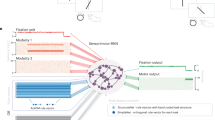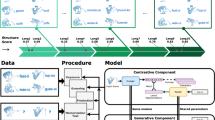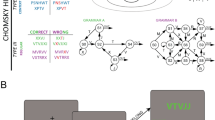Abstract
The neural networks that achieve linguistic skills in the brain are presently being uncovered by brain imaging methods using suitable psychophysical paradigms. We use these and other related results to guide the development of an overall neural architecture to implement Chomsky’s “Language Acquisition Device” or LAD. We then consider in more detail the twin problems of the generation of infinite length sequences and the complexity of the recurrent system that produces such sequences. A recurrent neural network approach is used, based on our cartoon version of the frontal lobes, to analyze these two problems. The first is shown to be soluble in principle for any set of words by means of a set of “phrase analyzers”, which contain complex neurones able to chunk suitable sequences. Further guidance from action and precept representations is indicated as helpful. The second problem is found to be solved by using the simplest level of chunking; this arises naturally in the learning process, according to a set of simulations, provided the task of language learning is suitably hard. We conclude with an overview of future developments to allow a full LAD to be developed so as to begin to approach adult speech.
Access this chapter
Tax calculation will be finalised at checkout
Purchases are for personal use only
Preview
Unable to display preview. Download preview PDF.
Similar content being viewed by others
References
Bowerman, M., Levinson, S.C. (Eds.) (2001) Language Acquisition and Conceptual Development. Cambridge: Cambridge University Press.
Brown, R. (1973) A First Language. Cambridge, MA: Harvard University Press.
Chappell, G.J., Taylor, J.G. (1993) The temporal Kohonen map. Neural Networks 6: 441–445.
Chomsky, N. (1972) Language and Mind. New York: Harcourt Brace.
Christiansen, M.H., Chater, N., Seidenberg, M.S. (Eds.) (1999) Connectionist models of human language processing: Progress and prospects. Special issue of Cognitive Science 23(4): 415-634.
Elman, J.L. (1990) Finding structure in time. Cognitive Science 14: 179–212.
Fiez, J.A. (1997) Phonology, semantics and the role of the left prefrontal cortex. Human Brain Mapping 5: 79–83.
Gabrieli, J.D.E., Poldrack, R.A., Desmond, J.E. (1998) The role of the left prefrontal cortex in language and memory. Proc. Natl. Acad. Sci. USA 95: 906–913.
Gleitman, L.R., Leiberman, M. (Eds.) (1995) Language. Cambridge, MA: MIT Press.
Goswami, U. (1998) Cognition in Children. Hove, East Sussex: Taylor & Francis.
Greenfield, P.M. (1991) Language, tools, and brain: The ontogeny and phylogeny of hierarchically organized sequential behavior. Behavioral and Brain Sciences 14: 531–595.
Haegman, L., Gueron, J. (1999) English Grammar. Oxford: Blackwell.
Halsband, U., Matsuzaka, Y., Tanji, J. (1994). Neuronal activity in the primate supplementary, pre-supplementary and premotor cortex during externally and internally instructed sequential movements. Neuroscience Research 20: 149–155.
Hazlehurst, B., Hutchins, E. (1998) The emergence of propositions from the co-ordination of talk and action in a shared world. Language and Cognitive Processes 13: 373–424.
Ho, E.K.S., Chan, L.W. (1994) How to design a connectionist holistic parser. Neural Computation 11: 1995–2016.
Hopfield, J.J. (1982) Neural networks and physical systems with emergent collective computational abilities. Proceedings of the National Academy of Sciences USA 79: 2554–2558.
Jennings, J.M., Mclntosh, A.R., Kapur, S. (1998) Mapping neural interactivity onto regional activity: An analysis of semantic processing and response mode interactions. Neurolmage 7: 244–254.
Jordan, M.I. (1986) Attractor dynamics and parallelism in a connectionist sequential machine. Proceedings of the Cognitive Science Society (Amhurst, MA), pp. 531–546.
Kempson, R., Meyer-Viol, W., Gabbay, D. (2000) Dynamic Syntax. Oxford: Black-well.
Kohonen, T. (1998) The Self-Organising Map. Berlin: Springer.
Monchi, O. (1998) Modelling Functions and Dysfunctions of the Anatomical Circuits Involved in Anterior Working Memory and Attentional Tasks. PhD Thesis, Department of Mathematics, King’s College, University of London (unpublished).
Monchi, O., Taylor, J.G. (1995) A model of the prefrontal loop that includes the basal ganglia in solving the recency task. Proc. WCNN’95, Washington, DC, Vol. 3, pp. 48–51.
Monchi, O., Taylor, J.G. (1997) In: J.A. Bullinaria, D.W. Glasspool, G. Houghton (Eds.) 4th Neural Computation and Psychology Workshop: Connectionist Representations. London: Springer-Verlag, pp. 142–154.
Monchi, O., Taylor, J.G. (1999) A hard wired model of coupled frontal working memories for various tasks. Information Sciences, 113: 221–243.
Pinker, S. (1994) The Language Instinct. London: Penguin Press.
Pinker, S. (1995) Language acquisition. In: L.R. Gleitman, M. Leiberman (Eds.) Language, Vol. 1. Cambridge, MA: MIT Press, pp. 135–182.
Plunkert, K. (Ed.) (1998) Language Acquisition and Connectionism. London: Psychology Press.
Silven, M. (2001) Attention in very young infants predicts learning of first words. Infant Behaviour and Development 24: 229–237.
Stanley, P. (2001) Aspects of Language Modelling by Neural Networks. King’s College M.Sc., Information Processing and Neural Networks Thesis, University of London (unpublished).
Steedman, M. (1999) Connectionist sentence processing in perspective. Cognitive Science 23: 415–634.
Steels, L., Vogt, P. (1997) Grounding adaptive language games in robotic agents. In: I. Harvey, P. Husbands (Eds.) Proceedings of the 4th European Conference on Artificial Life. Cambridge, MA: MIT Press.
Taylor J.G. (1995) Modelling the mind by PSYCHE. In: F. Fogelman-Soulie, P. Gallinari (Eds.). Proc. ICANN’95. Paris: EC2 & Co, pp. 543–548.
Taylor, J.G. (1996) New models of control from biology. In: I. Parmee, M.J. Denham (Eds.) Adaptive Computing in Engineering Design and Control 1996 (ACEDC’96), Proceedings of the 2nd International Conference of the Integration of Genetic Algorithms and Neural Network Computing and Related Adaptive Techniques with Current Engineering Practice.
Taylor, J.G. (1999a) Do virtual actions avoid the Chinese room? In: J. Preston, M. Bishop (Eds.) Views into the Chinese Room: New Essays on Searle and Artificial Intelligence. Oxford: Clarendon Press.
Taylor, J.G. (1999b) The Race for Consciousness. Cambridge, MA: MIT Press.
Taylor, J.G. (2001) LAD: The Long Haul. Lobal Technologies Internal Report. (http:/ /www.lobaltech.com).
Taylor, J.G. (2002) Paying attention to consciousness. Trends in Cognitive Sciences 6: 206–210.
Taylor, J.G., Alavi, F.N. (1996) A basis for long-range inhibition across cortex. In: J. Sirosh, R. Miikulainen, Y. Choe (Eds.) Lateral Interactions in Cortex: Structure and Function. http://www.cs.utexas.edu/users/nn/web-pubs/htmlbook96/.
Taylor, J.G., Taylor, N.R., (2000a) Analysis of recurrent cortico-basal ganglia-tha-lamic loops for working memory. Biological Cybernetics 82: 415–432.
Taylor, J.G., Taylor, N.R., King’s College Technical Reports: BT Reports I-VII. London.
Taylor, J.G., Taylor, N.R., Apolloni, B., Orovas, C. (2000) Constructing symbols as manipulable structures by recurrent networks. In: Proceedings of IJCNN’2000, Vol. 2.
Taylor, N.R., (1998) Temporal Sequence Storage by Neural Networks. PhD Thesis, Department of Mathematics, King’s College, University of London.
Taylor, N.R., Taylor, J.G. (1998) In: D. Heinke, G.W. Humphries, A. Olsen (Eds.) Connectionist Models in Cognitive Neuroscience: The 5th Neural Computation and Psychology Workshop. London: Springer-Verlag, pp. 92–101.
Taylor, N.R., Taylor, J.G. (1999a) Learning to generate temporal sequences by models of frontal lobes. IJCNN’99 Proceedings. Erlbaum.
Taylor, N.R., Taylor, J.G. (1999b) Modelling the frontal lobes in health and disease. ICANN’99 Proceedings. IEEE Press.
Taylor, N.R., Taylor, J.G. (2000b) Hard-wired models of working memory and temporal sequence storage and generation. Neural Networks 13: 201–224.
Thomas, M.S.C., Grant, J., Barham, Z., Gsödl, M., Laing, E., Lakusta, L., Tyler, L. K., Grice, S., Paterson, S., Karmiloff-Smith, A. (2001). Past tense formation in Williams syndrome. Language and Cognitive Processes: 16 (2/3), 143–176.
Varsta, M., Millan, J. del R., Heikkonen, J. (1997) A recurrent self-organising map for temporal sequence processing. Proceedings of ICANN’97, pp. 421–426.
Waibel, A. (1989) Modular construction of time-delay neural networks for speech recognition. Neural Computation 1: 39–46.
Waibel, A., Hanazawa, T., Hinton, G., Shikano, K., Lang, K. (1989) Phoneme recognition using time-delay neural networks. IEEE Transactions on Acoustics, Speech and Signal Processing 37: 328–339.
Wang, D.L., Arbib, M.A. (1990a) Complex temporal sequence learning based on short-term memory. Proceedings of the IEEE 78(9): 1536–1543.
Wang, D.L., Arbib, M.A. (1990b) Timing and chunking in processing temporal order. IEEE Transactions on Systems, Man, and Cybernetics 23: 993–1009.
Editor information
Editors and Affiliations
Rights and permissions
Copyright information
© 2003 Springer-Verlag London Limited
About this chapter
Cite this chapter
Taylor, N.R., Taylor, J.G. (2003). The Neural Networks for Language in the Brain: Creating LAD. In: Hecht-Nielsen, R., McKenna, T. (eds) Computational Models for Neuroscience. Springer, London. https://doi.org/10.1007/978-1-4471-0085-0_9
Download citation
DOI: https://doi.org/10.1007/978-1-4471-0085-0_9
Publisher Name: Springer, London
Print ISBN: 978-1-85233-593-9
Online ISBN: 978-1-4471-0085-0
eBook Packages: Springer Book Archive




